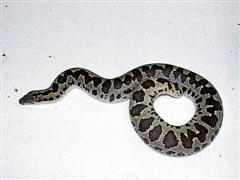Boa - Rough Scaled Sand
Scientific Name: Eryx conicus
Mon, 28th April, 2025 - 10:39 am GMT
Sponsor Ads:

Alternative Name
Scientific Name: Eryx conicusBasic Info
Rough Scaled Sand Boas reach an average of around two feet in length. The scales on the Rough Scaled Sand Boa are heavily keeled, or ridged, which is what gives the animal its name. The Rough Scaled's body is a shade of tan or grey dorsally and patterned with brown or reddish brown markings that connect forming a kind of zig-zag stripe down the back.
Health
Rough Scaled Boas do well in a 20-gallon-long terrarium that is kept between 80 and 85 degrees Fahrenheit during the day, with a basking area 90 to 95 degrees. At night the temperature should drop to about 70 degrees. They need to have 2 to 3 inches of substrate such as sand or aspen shavings to burrow in. Breeding Rough Scaled Sand Boas can breed between three and four years of age. The females give birth to live young, usually between four and thirteen at a time. The Rough Scaled Sand Boas generally breed between the months of February and April.Habitat
They usually are found on arid grasslands.Behavior
The Rough Scaled Sand Boa is a moderately small, burrowing snake from the Indian subcontinent. The hermit of the snake world, the Rough Scaled Sand Boa spends most of its time burrowed into the soil in which it lives. When hunting, they remain underground, allowing only their eyes and nostrils to venture to the surface. When unsuspecting prey ventures near, they seize the animal and kill it by constriction. In the wild, the Rough Scaled Sand Boa feeds primarily on small rodents and lizards. In very dry or very cold weather, the Rough Scaled Sand Boa often becomes dormant. Some specimens of Rough Scaled Boas are quite aggressive, although most snakes are generally docile if handled correctly and frequently.Origin
Middle EastHistory
The Rough Scaled Sand Boa can be found from Afghanistan and Iran throughout Pakistan and southern India. They were once often imported to Europe and the United States in great numbers, primarily for the pet trade. Rough Scaled Sand Boas available today are more likely captive bred than wild caught.Common Foods
feeds primarily on small rodents and lizardsSponsor Ads:
The good die young -- because they see it's no use living if you've got to be good --John Barrymore
Boa - Rough Scaled Sand
Coded by: BGID® | ALL RIGHTS RESERVED Copyright © 2000-2025
Disclaimer | Privacy | Report Errors / Contact | Credits










